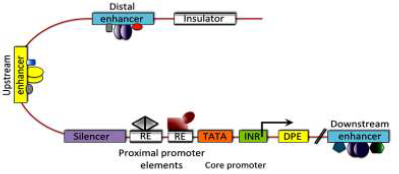Author: Ekatpure Sachin Chandrakant
Introduction :
The flow of genetic information in the cell starts at DNA, which replicates to form more DNA. Information is then ‘transcribed’ into RNA, and then it is “translated” into protein. For the complete process of gene regulation there is need of regulatory elements such as promoters and cis-acting elements. Co ordinate effect of these elements can induce the expression of gene.
Definition
Gene promoters are DNA sequences located upstream of gene coding regions and contain multiple cis-acting elements, which are specific binding sites for proteins involved in the initiation and regulation of transcription. In most transcription units, the promoters are located next to transcription start site but are not itself transcribed. Promoters normally contain a “core promoter”, which is a region found ∼40 bp upstream of the transcriptional initiation site which contains the TATA box. The TATA box is the binding site for the transcription initiation factor TFIID TBP (TATA-box-Binding Protein) subunit.
Upstream of the core promoter region are the proximal and distal regions of promoters. Proximal and distal regions of the promoter contain various regulatory sequences such as enhancers, silencers, insulators, and Cis-elements that contribute to the fine regulation of gene expression at the transcriptional level (Figure 1).

Figure 1: Different regulatory elements and there relative positions
During transcription, co-activators and transcription factors bind to specific DNA motifs and simultaneously interact with the transcriptional machinery attached to the core promoter. This complex DNA/protein relation leads to the activation, enhancement, or suppression of transcription. Thus, regulation of transcription depends on the: Availability and activity of transcription factors. The type, number, position, and combination of regulatory elements present in and around the promoter region. Regulation of gene expression at the promoter level is mainly controlled by the cis-acting elements localized upstream of the transcriptional start site
Conserved eukaryotic promoter elements
CAAT box: A consensus sequence close to -80 bp from the start point (+1). It plays an significant role in promoter efficiency, by increasing its strength. It seems to function in either orientation. This box is replaced in plants by a consensus sequence known the AGGA box.
TATA box: A sequence usually found around -25 bp upstream of the start point. The TATA box tends to be surrounded by GC rich sequences. The TATA box binds RNA polymerase II and a series of transcription factors
GC box: A sequence rich in guanidine (G) and cytosine (C) nucleotides. Is usually found in multiple copies in the promoter region, normally nearby the TATA box
CAP site: Is a transcription initiation sequence or start point defined as +1, at which the transcription process actually starts.
Consensus Sequences

Types of promoters used to regulate gene expression
There are different types of promoters are available in molecular biology are listed below. Promoters having its different functions and role in gene regulation.

These promoters dictate expression in almost all tissues and are largely, if not entirely, independent of environmental and developmental factors. As their expression is in general not conditioned by endogenous factors. Constitutive promoters are usually active across species and even across kingdoms.
Plant Pathogen promoters: CAMV 35 S and Opine promoter Monocot promoters: Plant Ubiquitin promoter (Ubi), Rice Actin 1 (Act-1) and Maize
dehydrogenase 1 (Adh1)
Advantages of constitutive Promoters:
• High level of production of proteins used to choose transgenic cells or plants;
• High level of expression of reporter proteins or scorable markers, allowing easy detection and quantification;
• High level production of a transcription factor that is part of a regulatory transcription system.
• Manufacturing of compounds that requires ubiquitous activity in the plant; and
• Production of compounds that are required during all stages of plant development
Tissue-specific or development-stage-specific promoters:
Tissue-specific promoters: which operate in particular tissues and at certain developmental stages of a plant. They may be produced by endogenous and exogenous factors, so they may be also classified as inducible. For plants, promoter elements that are expressed or affect the expression of genes in the vascular system such as photosynthetic tissues, Tubers, Roots, Other vegetative organs, Seeds, Reproductive organs can be found in heterologous systems. Tissue specific promoters are of three types. 1. Root Promoters, 2. Fruit Promoters, 3. Seed Promoters.
Inducible promoters:
These are only expressed under the presence of factors/compounds because their expression is normally limited to certain plant tissues. They can also be considered as tissue-specific Based on the nature of the factors that trigger their expression; they are classified into two groups:
Chemically-regulated: These are the chemical compounds, usually not naturally found within plants, switch on promoter activity. Several of the types of promoters involve chimeric components gathered from human, animal, fungal and bacterial sources. Pathogen related: Ethylene, SA, Thiamine, Benzol
Steroid regulated: Glucocorticoid receptors (GR) and Glucocorticoid response element (GRE)
Metal regulated: Copper, Zinc, Gold, Cobalt
Tetracycline regulated: Antibiotic resistance
Alcohol regulated
Physically-regulated: where abiotic and external factors such as light, heat, mechanical injury induce promoter activity
Temperature regulated: Heat inducible and cold inducible
Light regulated: Light inducible and light repressible
Synthetic promoters
Synthetic promoters are DNA sequences that do not found in nature and which are designed to regulate the activity of genes, controlling a gene’s ability to produce its own uniquely encoded protein.
References:
1. Potenza, C., Aleman, L. and Sengupta-Gopalan, C. 2004. Targeting transgene expression in research, agricultural, and environmental applications: promoters used in plant transformation. In Vitro Cellular & Developmental Biol. 40, pp. 1�"22.
2. Peremarti, A. et al. 2010. Promoter diversity in multigene transformation. Plant Mol. Biol., 73, pp. 363�"378.
About Author / Additional Info:
PhD research scholar (Plant biotechnology), interested in genetic engineering and molecular biology studies